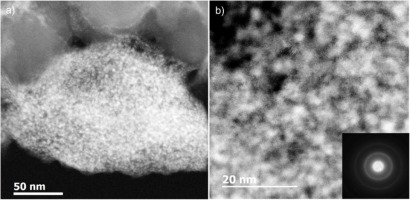当前位置:
X-MOL 学术
›
Solid State Sci.
›
论文详情
Our official English website, www.x-mol.net, welcomes your feedback! (Note: you will need to create a separate account there.)
Lithium-driven conversion and alloying mechanisms in core-shell Sn/SnOx nanoparticles
Solid State Sciences ( IF 3.5 ) Pub Date : 2020-03-01 , DOI: 10.1016/j.solidstatesciences.2020.106153 Nadia Soulmi , Moulay Tahar Sougrati , Lorenzo Stievano , Ana Gabriela Porras Gutierrez , Oleg I. Lebedev , Cécile Rizzi , Juliette Sirieix-Plénet , Laurent Gaillon , Henri Groult , Damien Dambournet
Solid State Sciences ( IF 3.5 ) Pub Date : 2020-03-01 , DOI: 10.1016/j.solidstatesciences.2020.106153 Nadia Soulmi , Moulay Tahar Sougrati , Lorenzo Stievano , Ana Gabriela Porras Gutierrez , Oleg I. Lebedev , Cécile Rizzi , Juliette Sirieix-Plénet , Laurent Gaillon , Henri Groult , Damien Dambournet

|
Abstract Sn-based electrode materials have been envisioned as an alternative to graphite owing to their high theoretical capacity. In this work, we embarked on investigating the lithium electrochemical mechanisms occurring in core-shell nanoparticles made of a tin metal core covered by an amorphous tin oxide shell. The electrochemical properties evaluated using galvanostatic experiments point to a dual contribution of core and shell components to the overall capacity. Operando Mossbauer spectroscopy allowed the identification of the different species involved during Li-driven electrochemistry, thus enabling the thorough monitoring of the gradual conversion process of tin oxide. Subsequently, Sn originating from both the conversion processes and the core reacted with lithium forming typical intermediate phases such as LiSn, Li5Sn2 and finally Li7Sn5. Upon charge, not only metallic Sn is recovered but surprisingly also tin oxide, confirming the reversibility of the conversion process. These results also underline an overlapping between conversion and alloying processes. Finally, after one cycle, the pristine core-shell morphology is not recovered, particles of 2–3 nm in size are instead observed.
中文翻译:

核壳型 Sn/SnOx 纳米颗粒中锂驱动的转化和合金化机制
摘要 Sn 基电极材料因其高理论容量而被设想为石墨的替代品。在这项工作中,我们开始研究核壳纳米粒子中发生的锂电化学机制,该纳米粒子由被无定形氧化锡壳覆盖的锡金属核制成。使用恒电流实验评估的电化学性能表明核和壳组分对总容量的双重贡献。Operando Mossbauer 光谱允许识别锂驱动电化学过程中涉及的不同物种,从而能够彻底监测氧化锡的逐渐转化过程。随后,来自转化过程和核心的 Sn 与锂反应形成典型的中间相,如 LiSn,Li5Sn2 和 Li7Sn5。充电时,不仅回收金属锡,而且令人惊讶地回收氧化锡,证实了转化过程的可逆性。这些结果还强调了转化和合金化过程之间的重叠。最后,在一个循环后,原始核壳形态没有恢复,而是观察到 2-3 nm 大小的颗粒。
更新日期:2020-03-01
中文翻译:

核壳型 Sn/SnOx 纳米颗粒中锂驱动的转化和合金化机制
摘要 Sn 基电极材料因其高理论容量而被设想为石墨的替代品。在这项工作中,我们开始研究核壳纳米粒子中发生的锂电化学机制,该纳米粒子由被无定形氧化锡壳覆盖的锡金属核制成。使用恒电流实验评估的电化学性能表明核和壳组分对总容量的双重贡献。Operando Mossbauer 光谱允许识别锂驱动电化学过程中涉及的不同物种,从而能够彻底监测氧化锡的逐渐转化过程。随后,来自转化过程和核心的 Sn 与锂反应形成典型的中间相,如 LiSn,Li5Sn2 和 Li7Sn5。充电时,不仅回收金属锡,而且令人惊讶地回收氧化锡,证实了转化过程的可逆性。这些结果还强调了转化和合金化过程之间的重叠。最后,在一个循环后,原始核壳形态没有恢复,而是观察到 2-3 nm 大小的颗粒。



























 京公网安备 11010802027423号
京公网安备 11010802027423号